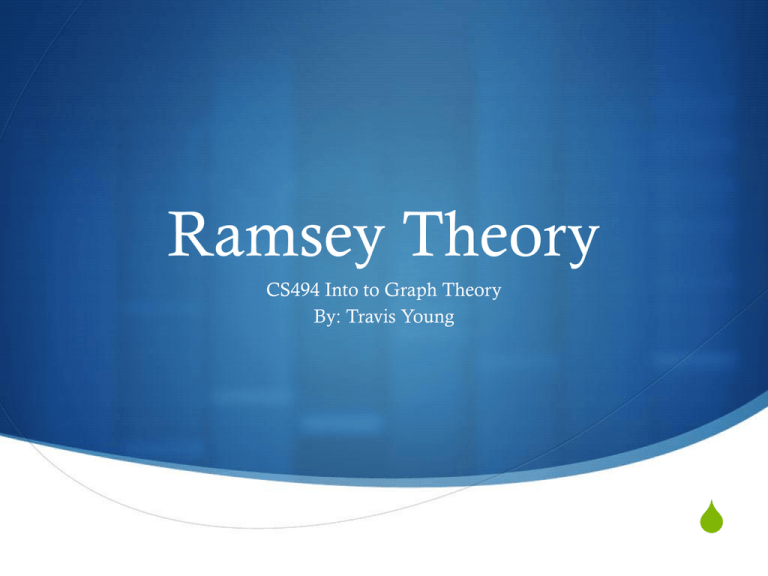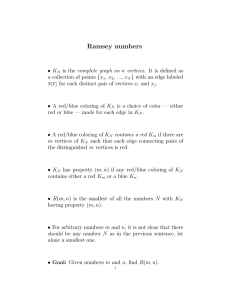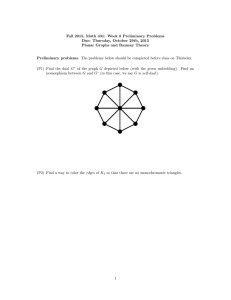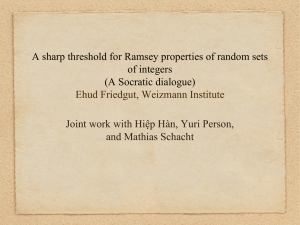Ramsey Theory S CS494 Into to Graph Theory By: Travis Young
advertisement

Ramsey Theory
CS494 Into to Graph Theory
By: Travis Young
S
Who is Ramsey and what is his
theory???
S Frank Plumpton Ramsey (22 February 1903 – 19 January 1930)
S British philosopher, mathematician and economist
S Studied at Trinity College, Cambridge
S Member of the Cambridge Apostles, (Intellectual Secret Society)
S Died at the age of 26
S Well versed in many subjects: Literature, Classics, Politics
S A little awkward though…..
S His best pick up line:
S “Margaret, will you **** with me???”
Ramsey Theory
S “Complete disorder is impossible”
- Theodore S. Motzkin (Israeli Mathematician)
S Essentially, if we have enough elements present in a system,
some order is bound to form.
S THIS IS HUGE!
S Given only the size of the system we are guaranteed certain
properties.
PROVE IT!!!
S Pigeon hole principle:
S 5 pigeons, 2 holes, one hole MUST contain at least 3 pigeons
S WHOA!
S 6 people on Facebook
S Friends or Strangers
S 215 or 32,768 possible arrangements
S Guaranteed to have either 3 friends OR 3 strangers
Terminology
S Complete Graph(Kn):
- Each node in the graph is connected to each other node
S Sub-graph:
- Subset of nodes of G with their corresponding edges
S Clique:
- Complete subgraph
S Edge Coloring:
- Select K colors and assign each edge a color
Ramsey Numbers
S Our First Ramsey Number:
R(3,3) <= 6
S In English: There exists a minimum number of nodes ‘n’ that’s
at most 6, such that any 2 coloring on those ‘n’ nodes will have
a monochromatic coloring that contains the clique K3
Formal Definition
S Generally: R(s,t) = n
S Represents the minimum number ‘n’ such that any 2-
coloring on Kn must have either a Ks whose edges are
monochromatic in color 1 or a Kt whose edges are
monochromatic in color 2
Behold:
S Ramsey’s Theorem:
R(s,t) < ∞ ∨s,t € N; s,t >= 2
Lets Prove it…
Proof by Induction on s+t:
S Base Case: s + t = 4 or R(2,2) = 2
Induction Hypothesis
S R(s,t) < ∞ if s+t = n-1
S We want to show: R(s,t) <= R(s-1,t) + R(s,t-1) when s+t = n
S Let N = R(s-1, t) + R(s, t-1)
V
KN
Generalizing Ramsey Theory
S R(n1, n2, n3,… nk) < ∞ ∨ni € N, ni >= 2
S Definition: R(n1, n2, n3,… nk)
S The minimum number of vertices, Q, required such that ANY
k-coloring on KQ, we are guarunteed a complete
monochromatic subgraph on ni vertices in color i
PROVE IT!
Proof by Induction on # of
colors, K
S Base Case:
R(n1,n2) < ∞
S Hypothesis:
R(n1,n2,… nK-1) < ∞
S Want to show:
R(n1,n2...nk-1, nk) <= R(n1,n2...nk-2, R(nk-1, nk)
R(3,3,3)
S The minimum number of N vertices required such that any
3-coloring on KN must have a complete subgraph on 3
vertices whose edges are monochromatic in one of those
colors
S Claim: R(3,3,3) = 17
S We Know R(3,3,3) > 16 as shown by R.E. Greenwood and
A.M. Gleason in “Combinatorial Relations and Chromatic
Graphs”
Proof
S Want to show: R(3,3,3) <= 17
Schurs Theorem
S Definition: For every K >= 2, where K is some number of
colors, there exists some n > 3 such that, given any kcoloring on the first n positive integers, there will be a
monochromatic x,y,z with the property:
x+y = z
Lets Explore
S First lets consider the case where K = 2, can we find an n?
* its important to note that x and y aren’t necessarily
distinct
Continuing on
S Consider an arbitrary K-coloring on n: R(3,3,3…3)
S We’ve already proven this number is finite previously
S Claim:
Given an arbitrary k-coloring on the first n positive integers,
we can find a monochromatic x,y,z such that x + y = z
S This is gonna sound crazy but…
S We can actually consider this K- coloring as a function
S Behold:
X:{1,2,3...n}
S Lets consider Kn
{K}
Color the edge
S Lets use our function X to help
S So X(j-i) is in fact an element in the set, and that element
has been assigned a color, and that’s the color we want that
edge to be
S Recall: Kn is a complete graph on n vertices with K colors
and n = R(3,3,3,…3) so were guarnteed to find a
monchromatic K3 on any 3 of these n vertices.
Continuing
S So lets say we found this triangle at i,j,k
S How do we express that with our function?
S X(j-i) = X(k-j) = X(k-i) i.e The edge colors are the same
S Let x = (j-i), y = (k-j), z = (k-i)
S Lets add x and y
DAMN
S We proved Schur’s Theorem
*but
S So this n, which we defined to be R(3,3,3,…3), isn’t
guarunteed to be the smallest n with this property.
S But it does show that there will exist some smallest n such
that this property holds.
Unsolved Mysteries
S Happy Ending Problem
S First considered by Esther Klein, George Szekeres and Paul
Erdos
S Draw 5pts such that no 3 are in a straight line
S Were looking for a convex set of 4pts
S It turns out that any 5 points MUST produce a four-sided
convex polygon: PROVEN (not the case with 4)
Happy Ending Problem
S So say we wanted a five-sided convex polygon? How many
points guarantee we get one?
S Turns out, the answer is 9: PROVEN (8 breaks it)
S How about 6?
S Answer is 17: PROVEN
The Conjecture
S Erdos and Szekeres:
2n-2 + 1 Points guarantees a convex n-gon
NOT PROVEN
Professor Ron Graham offers $1,000 of his “Erdos” money
(saved up in case of an emergency where someone actually solves
one of Erdos’s problems) to anyone who can prove or disprove
this. So, homework problem #1….
Ramsey Theory
S A bunch of points represents the complex system
S The n-gon is the order
S Does any 33 point lay-out guarantee a 7-sided convex polygon???
S 5: proved 40 years ago
S 6: proved recently with the aid of a fair amount of computer
power
S 7: Beyond computation
Grahams Number
S Consider K4
S Lets color it
S We want to avoid creating…wait for it...A monochromatic
k4 on a flat plane.
S This is avoidable in 2d, 3d.
S How about 4 dimension?
S Turns out, its avoidable. So is 5d and 6d and 7d…
S But can you always avoid it? NO
S There exists a “very large number” (thats a hilarious description),
sometimes known as Grahams Number, that you can’t avoid it.
PROVEN (its a nasty proof...best leave it for homework question
#2)
S We’ve proved out to 13 dimensions: 8,000 vertices 33,550,336 so
233,550,336 ways to color it. (You can’t compute that btw)
Homework Problems
S #1: Find the edge-chromatic number for Kn
S #2: Find the edge-chromatic number for the Peterson Graph
S #3: Find R(3,3)
S Works Cited:
S Kaj Hansen on Ramsey Theory(1-6)
https://www.youtube.com/watch?v=7p76yYMth5A
S “Happy Ending Problem”
https://www.youtube.com/watch?v=xPk3SZiFEvQ
S “What is Graham’s Number”
https://www.youtube.com/watch?v=HX8bihEe3nA&feature=
iv&src_vid=xPk3SZiFEvQ&annotation_id=annotation_25038
03343






